
Adopted at the 9th Congress of Freedom Road Socialist Organization in spring 2022.
Introduction
The 2008 financial crisis, the greatest since the Great Depression of the 1930s, exposed the fundamental weakness of U.S. monopoly capital and ushered in a new period of relative economic decline. The relative economic decline of the U.S. could also be seen by the rise of socialist China, which was able to surpass the United States in a number of ways. The growing polarization of income and wealth, as well as the blatant bail-out of big banks and corporations in 2008, gave birth to a new era of economic struggle and an openness to socialism here in the United States. The failure of the United States government to deal with the COVID-19 pandemic, leading to more than a million deaths, also created deep strains on the U.S. economy, including the highest inflation since the 1980s. The pace of climate change has sped up, as seen in the growing human and economic costs of storms, flooding, and fires. Last, but not least, the U.S. attempts to take on first China, then Russia, has opened a period of “de-globalization”, doing an about face on the U.S.-centered international economic system built up since World War II.
In the week leading up to the outbreak of the U.S.-Russia war over the Ukraine in 2022, President Biden’s national security advisor Jake Sullivan tried to prime the American people for war, saying that “we are 50 percent-plus of global GDP”, contrasting it with Russia’s 3 percent. How much of this was a big lie, and how much was delusional, may never be known, but the fact of the matter is that the United States, once 40 percent of global GDP in 1960, was down to 23 percent of world GDP as measured by market prices, and only 16 percent using economists preferred PPP, or purchasing power parity measure.1
The protest of radical youth of the Occupy Wall Street movement of 2010 following the 2008 financial crisis, has been followed by a powerful wave of strikes and unionization efforts in 2021 following the COVID-19 recession. The 2020 recession was met with a historic amount of federal government aid and massive expansion of the money supply by the Federal Reserve. However, the government spending and tax cuts largely ended in 2021. The Federal Reserve is also reversing course with plans to raise interest rates and sell off its huge stash of bonds in 2022.
The COVID-19 pandemic, in addition to killing more than a million Americans, was the biggest supply-side shock to the U.S. economy since the 1970s. Factories, such as those producing automobiles, shut down and could not return to full production due to a lack of parts. Transport networks were strained. Many workers could not or would not return to work as family illness, limited childcare, and worries about lack of workplace safety led to a wave of early retirements. The shortage of labor was made worse by the Trump administration’s clamp down on immigration, which has only been partially reversed by the Biden administration.
1. Inflation
Inflation in March and April of 2022 topped 8 percent, the highest rate of inflation in forty years. The last period of high inflation began in 1966 and topped out at more than 14 percent in 1980. The 1970s marked the start of the decline of the U.S. empire. The U.S. stopped backing the dollar with gold in 1971, the Arab oil embargo of 1973, the panicked collapse of the U.S. puppet government in the southern part of Vietnam in 1975, and finally the Iranian Revolution in 1979, were major defeats for U.S. imperialism. Severe economic shocks from the rising cost of oil changed the initial rise in inflation during the U.S. war in Vietnam during the 1960s into double-digit inflation in the 1970s.
The accelerating decline of U.S. imperialism today is seen in the COVID-19 debacle with over one million deaths in the U.S. The pandemic led to supply side problems across the economy causing shortages and pushing up inflation. The U.S. suffered an embarrassing loss in Afghanistan as the puppet government collapsed even before the last U.S. troops had left the country (in contrast, the South Vietnamese puppet government hung on for two years after the U.S. troop withdrawal). Most recently, the U.S. economic war on Russia failed to get support from a majority of countries and people around the world.
U.S. sanctions on Russia and the refusal of U.S. oil corporations to produce more has led to a spike in gasoline prices. Economic sanctions on China have at least temporarily blocked solar panel imports, causing prices to go up and holding up major renewable energy projects. The Trump administration’s anti-immigrant policies have not been rolled back by the Biden administration, contributing to shortages of workers. The flip side of inflation, shortages, can be seen in the empty shelves and critically ill infants without their needed formula. Monopolization of this industry along with restrictions on imports are the main causes.
The lower and middle strata of the working class are hardest hit by rising prices and shortages of necessities. Whatever savings that they might have built up from government aid during the pandemic has been run down. More and more people with lower credit scores, mainly low and middle strata workers, are falling behind on their loan payments. Another sign the working class is facing an economic squeeze is that retail stores such as Walmart and Target are seeing lower sales and profits.
2. Declining wages
With the burst of inflation that began in the second half of 2021, workers’ real wages or their purchasing power went into a tailspin as substantial money wage increases were surpassed by forty-year highs in inflation. But the decline in the purchasing power of workers’ wages is a long-term trend, as real (or inflation adjusted) wages for non-supervisory workers have fallen almost 12 percent in the last thirty years.
With the product that a worker creates in each hour of work going up, there is a growing gap between their wages and the product created by their labor. This means there is increasing exploitation of the working class, which has meant growing profits. These profits flowed to the monopoly capitalists who own most means of production, with the stock market hitting new record highs at the end of 2021.
In addition to falling real wages, workers have been hit by increased use of part time and temporary work, and recently the so-called “gig” economy that leaves the workers without stable pay and usually no benefits or unemployment insurance. This erosion of purchasing power and job stability is the basis for the growing number of strikes and unionization drives.
Much of the so-called “great resignation”, or record numbers of people quitting their jobs, is because more and more businesses refuse to give workers full time jobs that they can live on. A major cause of the supply chain shortages that are driving up prices is a shortage of long-haul truckers. Trucks move most of the country’s freight, while the drivers earn an average of $50,000 a year to basically live in their trucks for weeks at a time.
What this means is that 50-80 percent of working people (depending on the survey) are living paycheck to paycheck or are earning just enough to meet their needs. More and more households are borrowing to deal with day-to-day expenses. Consumer credit increased by one trillion dollars in 2021 alone, as the end of government pandemic aid cut into household budgets.
3. Government cuts or austerity
During and following the COVID-19 pandemic recession, the U.S. government cut taxes and increased spending by more than $3 trillion dollars each year in 2020 and 2021. This came in the form of the so-called paycheck protection program, (which mainly went to non-payroll spending by businesses), expanded unemployment insurance, relief checks to most households (but excluding undocumented immigrants), rent and mortgage relief, suspending student loan payments, and aid to specific industries such as airlines. Much of this never got to the unemployed workers and low-income households who needed aid the most, but it was still a record-breaking amount.
However, virtually all these programs have been undone or will end in 2022. This austerity will be a drag on the economy and can already be seen in more and more school districts and local and state governments starting to make cuts. Lower and middle working-class households have already spent most of their relief checks and will be starting to tighten the belt.
The last two remaining reforms, the moratorium on student loan repayments and suspension of Medicaid income verification, will end in 2022. Resuming student loan payments, which average $300 per month, will affect more than 45 million people. Another 15 million could lose their Medicaid health insurance and will have to pay much more for private insurance. Rural hospitals were already on the financial edge before the pandemic. With the end of Federal pandemic aid, as many as 500 rural hospitals could close in the next two years.
The Federal government’s response to the COVID-19 recession did include badly needed reforms such as the Pandemic Unemployment Assistance (PUA) for self-employed and gig workers, and the expansion of the Child tax credit. However, neither was made permanent, so no major reforms have come out of the recession. This reflects the lack of a mass movement, such as in the Great Depression of the 1930s, as well as the shift to the right (relative to the past) and weakness of the Democratic Party.
The growing U.S. involvement in the war in the Ukraine is already colliding with spending on domestic needs. In March of 2022, the Democratic leadership of the House stripped out more COVID aid while including new military aid to the Ukrainian government. This came exactly when a new, more contagious form of the Omicron COVID variant named “B.2” is spreading in many countries.
4. Housing
The housing boom from 2003 to 2006 and then the bust led to the Financial Crisis in 2008. The crisis caused a turnaround in the long-term trend of more and more households becoming homeowners. After peaking in 2005 at about 69 percent, homeownership is now less than 66 percent. African American home ownership was hit especially hard: not only was it much lower at its peak in 2004 at almost 50 percent, the drop to 43 percent is more than twice as much as the drop in homeownership among white Americans.
This drop in homeownership has meant more people are renters, so that landlords can squeeze even more surplus from workers. Furthermore, greater numbers of homes for rent are owned by big corporate landlords, which are more willing and able to evict tenants. While rents fell briefly following the 2020 recession, the rate of increase of rents has bounced back to pre-pandemic levels. Housing prices are rising even faster, which is pricing more and more people out of homeownership and into the rental market, adding to the pressure for higher rents.
Housing costs are also now starting to show the effects of climate change. Insurance companies are jacking up premiums, limiting coverage, and even pulling out of areas altogether. Utilities are raising rates at an accelerated pace to try to respond to costs of wildfires, flooding, and severe storms which grow more and more common. While the wealthy can afford to move, protect their properties, or just pay the higher costs, working class and poor people are being forced out of their homes.
Home equity is the most widespread form of wealth, but rising home prices over the last ten years have increased wealth inequality. High income households have almost doubled their share of home equity, rising from 28 percent in 2010 to 42.6 percent in 2020. The share of home equity held by middle and low-income households has fallen from 72 percent to 57.4 percent. The housing crisis can be seen in the growing number of homeless. While the official government count is less than a million, considering the uncounted homeless — those that are couch surfing, living in their vehicles, or even at their workplaces — pushes that total closer to three million, or almost one percent of the U.S. population. Nothing shows the growing contradiction of capitalism like homeless living on the streets and near freeways within sight of multi-million-dollar homes.
5. The crisis of imperialist globalization
The first signs that the U.S.-led imperialist globalization of the post-World War II period was in trouble was the breakdown of the Doha round of negotiations back in 2005, at which a group of developing countries, led by China and India, refused to accept the U.S. agenda, which excluded discussion of imperialist countries’ agricultural subsidies.
The 2008 financial crisis, which spread around the world with the globalization of banking and finance, showed that the promise of common prosperity under capitalism and free trade also meant the reality of common economic ruin. The housing boom and bust, and financial crisis not only hit the United States, but almost wrecked the European economic integration project in the Euro crisis.
President Trump’s tariffs were a historic turnaround in the U.S.-led effort to lower tariffs in the interest of free trade. While the U.S. had always wanted free trade that would benefit its corporations, but dragged its feet on farm subsidies, this was the first time since the Great Depression of the 1930s that the United States targeted other imperialist countries with tariffs. Of course, the main target had always been socialist China. While the Biden administration dropped the tariffs on goods from other imperialist countries, there are no signs that the U.S. will cut the steep 25 percent tariffs on about half of what the U.S. imports from China.
COVID-19 was another shock to imperialist globalization, as attempts to control the spread of the virus snarled international supply chains. The sharp U.S. economic bounce, fed by trillions of dollars of U.S. government aid and ultra-low interest rates, has increased pressure on international trade, with ships backed up outside harbors and containers piling up in ports.
Last, but not least, the U.S. and NATO countries’ economic war on Russia, in response to the war in the Ukraine, ever more clearly shows that so-called globalization is not about the mutual benefit of free trade – it is about the economic domination of imperialist countries. But by cutting Russia off from the U.S. dollar-centered capitalist financial system, the U.S./NATO economic war shows that not only poor countries like Afghanistan can be raided by the pirates of Washington D.C. and Wall Street, but so can more powerful countries like Russia. This is likely to lead more and more countries to diversify their foreign exchange holdings away from the U.S. dollar, with the Chinese RMB being the most likely alternative.
Russia has not yet struck back against the West’s economic war, but it could embargo oil and natural gas exports. This would hit Europe especially hard, as almost one-third of its natural gas comes from Russia.
6. Recession
While the downturn of 2020 is officially a recession, it was unlike any other recession on record. Except for the recessions following the end of World War II, World War I, and the Civil War where there were big drops in military spending, every other recession has been accompanied by a sizable drop in investment spending. Official recessions are then confirmed by a drop in employment, or variable capital.
Stripping out changes in inventories (which are counted as investment in standard Keynesian national income accounting), increases in fixed capital have been very weak for the last nine months of 2021. Combined with growing austerity by the government and rising interest rates by the Federal Reserve meant to slow inflation, there is a growing likelihood of a recession in the near future.
A future recession could be worsened by political opposition to more stimulus from the Federal Government, and the Federal Reserve’s commitment to fight inflation would prevent it from fighting a recession. Without the massive government aid and near zero interest rates seen in the last two recessions (2020 and 2008), the economy could see a bad recession more like 1981, when the Fed was also committed to fighting inflation.
7. U.S. economic cold war with China
China’s socialist economic model is becoming more attractive to other nations and peoples of the world. China’s GDP, using PPP, was already larger than that of the United States last year. China is leading in transportation, in miles of high-speed rail, and production of electric autos and buses. China is also a leader in green energy in terms of solar energy and wind turbines, as well as communications, from quantum communications to the roll-out of 5G cellular service. China’s space program is making steady progress and is racking up several firsts, especially in the exploration of the far side of the moon. China’s financial system is the first to roll-out a Central Bank Digital Currency or CBGC, while the United States and other capitalist countries are lagging behind, as this would cut into financial corporations’ profits. While socialist China has been able to eliminate extreme poverty, economic inequality continues to grow in the United States with every economic crisis.
The U.S. government clearly sees China as the main threat to the empire, and labels efforts to restore U.S. economic leadership as combating China. The economic war with China started by Trump has not subsided, with the United States issuing new threats almost every month.
The United States’ economic cold war with China is not without costs to the United States economy. The Trump administration put 25 percent tariffs on about half of the Chinese goods that the United States imports. The Biden administration continues these tariffs, which have mainly been paid by U.S. consumers in the form of higher prices. U.S. bans on Chinese battery buses and steep tariffs on solar panels have slowed the fight against climate change, even as the United States has the highest CO2 emissions per person for any large economy.
Conclusion
The relative decline of the U.S. economy, and the most dramatic blows to the Empire in the past forty years, shows that the short period of relative resurgence of the United States in the 1990s is over. While it is more difficult to see the path ahead, a few economic trends are clear:
The post-World War II era of imperialist globalization is over. With the U.S. resorting more and more to economic wars with Iran, Venezuela, China, and now Russia, it is increasingly clear that globalization is domination by the United States and other imperialist countries. The U.S. dollar will come under increasing pressure as additional countries try to free themselves from U.S. financial domination.
The U.S. ruling class will try to shift the burden of U.S. economic wars onto the backs of American workers and other oppressed people. Thirty years of relatively low inflation are giving way to a period of higher inflation, with many similarities to the 1970s. In that decade, the United States was defeated in Vietnam and faced a major supply-side shock from the oil embargo in protest of U.S. support for Israel. In the last year, there has been the U.S. defeat in Afghanistan, where the puppet government fell even before the last U.S. soldier left, major supply-side shocks from tariffs, COVID, and now the U.S.-Russian war in the Ukraine.
The concentration and centralization of capital mean giant corporations and monopoly landlords are displacing small businesses and landlords at an accelerating pace. This is restricting economic mobility through small businesses and home ownership. More and more people are seeing through the myth of competitive capitalism to the reality of more monopoly corporations.
Resistance is also growing, some spontaneous and individual, such as record levels of quits from low-wage and part time jobs. Others are organizing through unionization drives at major corporations such as Amazon and Starbucks.
Our job, now more than ever, is to direct the anger of the masses over growing economic pain toward the monopoly capitalist class, and to raise the level of struggle for socialism.
1 PPP or purchasing power parity, is a way of comparing economies considering that (a) the same product can have different prices in different countries. Since GDP is measured on market prices, this would mean that the country with higher prices would seem to have a larger economy; and (b) that comparing nominal GDP uses exchange rates that are mainly driven by investment flows and does not represent production.





